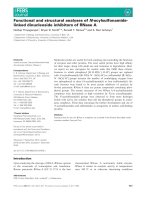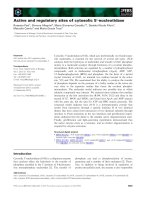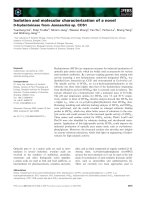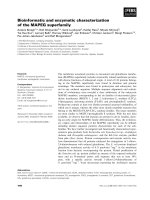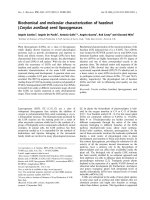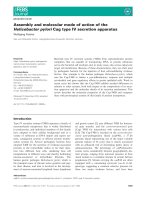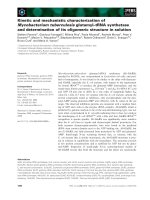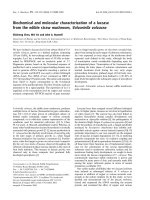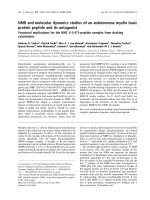Báo cáo khoa học: Biochemical and molecular characterization of purified chicken pancreatic phospholipase A2 docx
Bạn đang xem bản rút gọn của tài liệu. Xem và tải ngay bản đầy đủ của tài liệu tại đây (845.18 KB, 10 trang )
Biochemical and molecular characterization of purified
chicken pancreatic phospholipase A
2
Aida Karray, Fakher Frikha, Abir Ben Bacha, Yassine Ben Ali, Youssef Gargouri
and Sofiane Bezzine
Laboratoire de Biochimie et de Ge
´
nie Enzymatique des Lipases, ENIS, Sfax, Tunisia
Introduction
Phospholipases A
2
(PLA
2
s; EC 3.1.1.4) hydrolyze
stereospecifically the 2-acyl ester bond of 1,2-diacyl-
sn-3-phosphoglycerides, generating fatty acids and
lysophospholipids. Several PLA
2
s have been identified
on the basis of their gene sequences. They have been
classified mainly into three groups: (a) cytosolic PLA
2
;
(b) Ca
2+
-independent intracellular PLA
2
; and (c)
Ca
2+
-dependent secreted PLA
2
(sPLA
2
). They differ
from each other in terms of substrate specificity, Ca
2+
requirement, and lipid modification. There is also a
PLA
2
class that hydrolyzes platelet-activating factor
(1-O-alkyl-2-acetyl-sn-glycero-3-phosphocholine) and
oxidized lipids, called platelet-activating factor acetyl-
hydrolases [1,2].
sPLA
2
s form one of the main classes within the
PLA
2
superfamily, and some of their members are well
characterized. Important common structural features
of the sPLA
2
s are well conserved: the central a-helices
with the catalytic His–Asp dyad, and the hydrogen-
bonding network connecting the interfacial binding
site, the catalytic site and the Ca
2+
-binding site [3].
Eleven sPLA
2
s have been identified in mammals
(groups IB, IIA, IIC, IID, IIE, IIF, V, X, III, XIIA,
and XIIB). They display partially overlapping tissue
Keywords
bile salts; chicken; modeling; phospholipase
A
2
; purification
Correspondence
S. Bezzine, Laboratoire de Biochimie et de
Ge
´
nie Enzymatique des Lipases, ENIS,
Route de Soukra, 3038 Sfax, Tunisia
Fax: +216 74675055
Tel: +216 74675055
E-mail: sofi
Database
The nucleotide sequence of ChPLA2 deter-
mined in this study has been deposited in
the GenBank database under the accession
number EU617018
(Received 13 March 2009, revised 7 June
2009, accepted 17 June 2009)
doi:10.1111/j.1742-4658.2009.07160.x
Chicken pancreatic phospholipase A
2
(ChPLA
2
) was purified from delipi-
dated pancreases using ammonium sulfate and ethanol precipitation,
followed by sequential column chromatography steps on MonoQ Sepha-
rose and size exclusion HPLC columns. ChPLA
2
was found to be a non-
glycosylated monomeric protein with a molecular mass of 14 kDa and a
specific activity of 400 UÆmg
)1
in the presence of 1 mm sodium taur-
odeoxycholate and 4 mm CaCl
2
with phosphatidylcholine as substrate. The
N-terminal sequence of the first 15 amino acids of ChPLA
2
was deter-
mined, and showed a high degree of homology with known mammal pan-
creatic phospholipases A
2
. The gene encoding the mature ChPLA
2
was
cloned and sequenced. The deduced amino acid sequence of the mature
ChPLA
2
confirmed the high level of identity with mammal pancreatic
PLA
2
. To investigate the structure–activity relationships, a 3D model of
group IB ChPLA
2
was built using the porcine pancreatic phospholipase A
2
structure as template.
Abbreviations
ChPLA
2
, chicken pancreatic phospholipase A
2
; DrPLA
2
, dromedary pancreatic phospholipase A
2
; NaTDC, sodium taurodeoxycholate; OPLA
2
,
ostrich pancreatic phospholipase A
2
; PC, phosphatidylcholine; PLA
2
, phospholipase A
2
; PPLA
2
, porcine pancreatic phospholipase A
2
; sPLA
2
,
secreted pancreatic phospholipase A
2
; TPLA
2
, turkey pancreatic phospholipase A
2
.
FEBS Journal 276 (2009) 4545–4554 ª 2009 The Authors Journal compilation ª 2009 FEBS 4545
distributions [3,4]. Only sPLA
2
-IB and sPLA
2
-X have
an N-terminal prepropeptide, and the proteolytic
cleavage of this prepropeptide is the regulatory step
for the generation of an active enzyme [5]. sPLA
2
-IB is
found in large amounts in the pancreas, and its princi-
pal function is the digestion of dietary lipids [5]. How-
ever, sPLA
2
-IB is also found in nondigestive tissues,
including the lung, spleen, gonad, and kidney [4,6].
Receptors of this enzyme have been identified in vari-
ous tissues, and sPLA
2
-IB is reported to play a role in
cell proliferation and hormone release via these recep-
tors [6,7].
Group IB sPLA
2
s have been isolated from the pan-
creases of various mammal species [8–13]. In contrast,
few studies have been performed on the bird PLA
2
[14,15]. Recently, Ben Bacha et al. [15] biochemically
characterized an active thermostable PLA
2
from
ostrich pancreas (OPLA
2
). It is therefore interesting to
investigate more biochemical and structural properties
of other purified bird PLA
2
s to gain more insights into
their mode of action on phospholipids. We describe in
this study the purification and some biochemical prop-
erties of an sPLA
2
from chicken pancreas (ChPLA
2
).
This article also reports, for the first time, the cloning
of a bird PLA
2
cDNA and a comparison of the corre-
sponding amino acid sequence with that of known
mammal PLA
2
s. Molecular modeling was also pro-
posed to explain some biochemical differences between
ChPLA
2
and other pancreatic PLA
2
.
Results and discussion
Purification of ChPLA
2
Thirty grams of delipidated chicken pancreas was sus-
pended in 300 mL of buffer A (10 mm Tris ⁄ HCl, pH
8.5, 10 mm CaCl
2
, 0.15 m NaCl) and ground mechani-
cally twice for 30 s at room temperature using the
Waring Blendor System. The mixture was then stirred
for 30 min at room temperature and centrifuged for
30 min at 12 000 g. The endogenous trypsin was found
to be sufficient to achieve PLA2 activation, as the total
PLA
2
activity obtained (2240 U) did not increase when
trypsin was added at different ratios to the PLA
2
solu-
tion (data not shown).
Ammonium sulfate precipitation
Chicken pancreatic extract was brought to 65% satu-
ration with solid ammonium sulfate under stirring and
maintained for 30 min at 4 °C. After centrifugation
(30 min, 12 000 g 4 °C), the precipitate was resus-
pended in minimum volume of buffer A containing
2mm benzamidine. Insoluble proteins were removed
by centrifugation (15 min, 24 000 g). The recovery of
PLA
2
activity was about 49%.
Ethanol fractionation
Resuspended precipitate (50 mL) was subjected to frac-
tionation using ethanol, 21.5 mL of ethanol 30% (v ⁄ v)
being added at 0 °C. Insoluble proteins were removed
by centrifugation (30 min, 24 000 g 4 °C), and ethanol
was again added slowly at 0 °C to the supernatant,
increasing the alcohol concentration to 80% (v ⁄ v). Pre-
cipitated proteins, which contained about 43% of the
starting amount of PLA
2
, were solubilized in a mini-
mum volume of buffer A containing 2 mm benzami-
dine. In the present study, we have found that this
step is of prime importance for eliminating the residual
lipids and facilitating the ChPLA
2
purification. The
resulting sample was dialyzed overnight against 20 mm
Tris ⁄ HCl buffer (pH 8) containing 20 mm NaCl and
2mm benzamidine (buffer B).
Anion exchange and gel filtration chromatography
The dialyzed sample (40 mL, 970 U) of ChPLA
2
was
centrifuged (10 min, 12 000 g at 4 °C) and poured
into a MonoQ Sepharose column (3 · 7.5 cm) equili-
brated with buffer B. Under these conditions, the
enzyme is adsorbed to the cationic support. The col-
umn was washed with 200 mL of buffer B containing
100 mm NaCl to eliminate some contaminant.
ChPLA
2
was eluted from the MonoQ Sepharose col-
umn upon a single wash with the same buffer con-
taining 200 mm NaCl. Fractions containing ChPLA
2
activity were pooled and concentrated (Fig. 1A). The
recovery of ChPLA
2
after the MonoQ step was
25%, with a specific activity of 50 UÆmg
)1
. The
concentrated proteins were loaded on a Bio-sil SEC-
125 size exclusion HPLC column (300 · 7.8 mm)
equilibrated in buffer C [0.1 m phosphate buffer (pH
6.8) containing 0.15 m NaCl]. Elution was performed
with phosphate buffer at 1 mLÆmin
)1
, and ChPLA
2
emerged 7 min after injection (Fig. 1B). The fractions
containing the PLA
2
activity were pooled, and
SDS ⁄ PAGE analysis revealed only one band corre-
sponding to ChPLA
2
. The molecular mass of
ChPLA
2
as estimated by gel filtration on HPLC was
14 kDa (Fig. 1B). Oligosaccharide analysis of the
pure ChPLA
2
indicated that the enzyme was not gly-
cosylated, similarly to all previously described pancre-
atic PLA
2
s (data not shown). Altogether, these results
suggest that ChPLA
2
is a monomeric protein, like the
PLA
2
s from the ostrich and all mammals.
Chicken pancreatic PLA
2
A. Karray et al.
4546 FEBS Journal 276 (2009) 4545–4554 ª 2009 The Authors Journal compilation ª 2009 FEBS
The purification flow sheet given in Table 1 shows
that the specific activity of pure ChPLA
2
reached
400 UÆmg
)1
when phosphatidylcholine (PC) was used
as substrate, at pH 9.5 and 37 °C, in the presence of
1mm sodium taurodeoxycholate (NaTDC) and 4 mm
CaCl
2
. The ChPLA
2
purification yield was 16%,
which is comparable to that obtained for the dromedary
PLA
2
(DrPLA
2
) and porcine PLA
2
(PPLA
2
) [5,13].
Moreover, the procedure described here is more rapid
than those used to purify mammal pancreatic PLA
2
.In
fact, ChPLA
2
was purified after only two chromato-
graphy steps, whereas in the case of DrPLA
2
or PPLA
2
,
four chromatography steps were needed [5,13].
Enzymatic properties of the purified ChPLA
2
Ca
2+
dependence
It is well established that Ca
2+
is essential for both
catalysis and enzyme binding to the substrate [16,17].
In this study, we measured ChPLA
2
activity at pH 9.5
and at 37 °C, using PC as substrate, in the presence of
increasing concentrations of Ca
2+
(Fig. 2A). No PLA
2
Fraction no
0
0.2
0.4
0.6
0.8
1
1.2
A
B
0 10 20 30 40 50 60 70
0
10
20
30
40
50
60
PLA2 activity (U·mL
–1
)
Absorbance (280 nm)
[NaCl] mM
0.2
0.3
0.1
Molecular mass
markers; MM (kDa)
1
10
30
100
Active fraction
0 2 4 6 8
10
12
14 16 18
Absorbance (280)
Time
(
min
)
0.064
0.054
0.044
0.034
0.024
0.014
0.0043
14
20
30
43
67
97
MM
(kDa)
1 2 3
Fig. 1. (A) MonoQ chromatography. A
Mono-Q column (3 · 7.5 cm) was prepared
and equilibrated with buffer B (20 m
M
Tris ⁄ HCl, 20 mM NaCl, 2 mM benzamidine).
The dialyzed sample from ethanol precipita-
tion was poured into this column, and fixed
proteins were eluted with 200 mL of the
same buffer containing 100 m
M NaCl fol-
lowed by 150 mL containing 200 m
M NaCl.
Fractions containing ChPLA
2
were eluted at
a flow rate of 45 mLÆh
)1
. The horizontal bold
line represents pooled samples from frac-
tion no. 36 to fraction no. 48. (B) Filtration
on HPLC column and SDS-PAGE (15%)
analysis of ChPLA
2
. Left panel: filtration
on a Bio-sil SEC-125 HPLC column
(300 cm · 7.8 mm) equilibrated in buffer C
(0.1
M phosphate buffer, pH 6.8, containing
0.15
M NaCl). Elution was performed at
room temperature within 20 min, with the
same buffer at a flow rate of 1 mLÆmin
)1
.
Molecular mass markers were used to esti-
mate the molecular masses of eluted pro-
teins. Right panel: SDS ⁄ PAGE (15%). Lane
1: molecular mass markers. Lane 2: 10 lg
of fractions eluted and concentrated from
Mono-Q chromatography. Lane 3: 10 lgof
fractions eluted from HPLC filtration and
containing ChPLA
2
activity. The gel was
stained with Coomassie blue.
Table 1. Flow sheet of ChPLA
2
purification; 30 g of defatted pancreas obtained from 100 g of fresh tissue was homogenized in 300 mL of
buffrer (10 m
M Tris ⁄ HCl, pH 8.5, 10 mM CaCl
2
, 0.15 M NaCl). Total activity: 1 U is lmole of fatty acid released per minute with PC as sub-
strate in the presence of 1 m
M NaTDC and 4 mM CaCl
2
. Protein concentrations were estimated by the Bradford method [26]. The experi-
ments were conducted four times.
Purification step Total activity (U) Total protein (mg) Specific activity (UÆmg
)1
) Yield (%) Purification factor
Extraction (pH 8.5) 2240 11 200 0.2 100 1
(NH
4
)
2
SO
4
precipitation (25–65%) 1100 1833 0.6 49 3
Ethanol precipitation (30–80%) 970 323 3 43 15
MonoQ Sepharose 600 12 50 26 250
Filtration (HPLC) 360 0.9 400 16 2000
A. Karray et al. Chicken pancreatic PLA
2
FEBS Journal 276 (2009) 4545–4554 ª 2009 The Authors Journal compilation ª 2009 FEBS 4547
activity was determined in the presence of chelators
such as EDTA or EGTA at 10 mm. In the absence of
chelators, the specific activity of ChPLA
2
increased to
reach 400 UÆmg
)1
at 4 mm CaCl
2
(Fig. 2A). In agree-
ment with previous findings regarding mammal pancre-
atic PLA
2
[8–10,12–14,18], our study also attempted to
show that bird PLA
2
requires the presence of Ca
2+
to
trigger the hydrolysis of phospholipids.
Bile salts dependence
Several studies have provided evidence that micellar
concentration of bile salts ensure the dispersion of the
hydrolysis products [12,19]. In order to investigate the
effect of bile salts on ChPLA
2
activity, the rate of
hydrolysis of PC by ChPLA
2
in the presence of vari-
ous concentrations of bile salts, at pH 9.5 and at
37 °C, was studied.
As shown in Fig. 2B, in contrast to all other known
PLA
2
s, which are bile salt dependent [8–10,12–14,18],
ChPLA
2
displays 50% of its maximum activity in the
absence of this detergent. The maximum phospholipase
activity was measured at 1 mm NaTDC.
Effect of temperature on ChPLA
2
activity and stability
As shown in Fig. 3A, ChPLA
2
maximal activity was
measured at 37 °C, using PC as substrate in the pres-
ence of 4 mm Ca
2+
and 1 mm NaTDC. The purified
enzyme was found to lose more then 50% of its activ-
ity at temperatures higher than 40 °C (Fig. 3B). Simi-
lar results were obtained with turkey pancreatic PLA
2
(TPLA
2
), which is completely inactivated at 60 °C [14].
In contrast, PPLA
2
, taken as a model of mammal
PLA
2
, can tolerate incubation at high temperature
(Fig. 3B).
Effect of pH on ChPLA
2
activity and stability
The maximal activity of ChPLA
2
was measured at pH
9.5, using PC as substrate in the presence of 4 mm
Ca
2+
and 1 mm NaTDC. ChPLA
2
was inactivated
after incubation for 30 min at pH values lower than 4
(Fig. 3D) [14]. For further comparison, we report the
results obtained with PPLA
2
. As shown in Fig. 3D,
PPLA
2
was found to be more resistant at pH 3 than
ChPLA
2
.
N-terminal sequence analysis of ChPLA
2
ChPLA
2
N-terminal sequencing allowed the unambigu-
ous identification of 15 residues of the pure enzyme.
The results presented in Table 2 show the alignment of
the N-terminal sequence of ChPLA
2
with those of
TPLA
2
[14], OPLA
2
[15], DrPLA
2
[13], PPLA
2
[20],
bovine PLA
2
[20], and human PLA
2
[21]. The N-termi-
nal sequences of bird PLA
2
s exhibit more than 66%
identity with those of mammal PLA
2
s.
Cloning and sequencing of the gene coding for
the mature PLA
2
The cDNA encoding ChPLA
2
was selectively amplified
by RT-PCR from total mRNA extracted from chicken
pancreas, as described in Experimental procedures.
The corresponding DNA was ligated into PCR-Blunt
vector and used for transformation into Escherichia coli
0
100
200
300
400
500
0 2
4 6
[NaTDC] (mM)
Specific activity (U·mg
–1
)
0
100
200
300
400
500
0 2 4 6 8 10 12
Specific activity (U·mg
–1
)
[CaCl
2
] (mM)
*
A
B
Fig. 2. (A) Effect of Ca
2+
concentration on ChPLA
2
activity. Enzyme
activity was measured at increasing concentrations of Ca
2+
, using
PC as substrate, at pH 9.5 and at 37 °C in the presence of 1 m
M
NaTDC. The star indicates the phospholipase activity measured in
the absence of CaCl
2
and in the presence of 10 mM EDTA or
EGTA. (B) Effect of increasing concentrations of bile salts (NaTDC)
on ChPLA
2
activity. PLA
2
activity was measured using PC as sub-
strate, at pH 9.5 and at 37 °C in the presence of 4 m
M Ca
2+
.
Chicken pancreatic PLA
2
A. Karray et al.
4548 FEBS Journal 276 (2009) 4545–4554 ª 2009 The Authors Journal compilation ª 2009 FEBS
DH5a cells. Several clones were selected, and some of
them contained a recombinant plasmid with a 500 bp
EcoRI insert. The cDNA sequencing confirmed that
the PCR product corresponded to the gene coding for
the mature ChPLA
2
(Fig. 4). The deduced polypeptide
sequence of ChPLA
2
, corresponding to the mature
protein, comprises 124 amino acids and has a calcu-
lated molecular mass of 14 167 Da. As revealed by
sequence similarity with pancreatic PLA
2
, ChPLA
2
shares 65% identity with PPLA
2
. Residues of the cata-
lytic diad and the pancreatic loop are conserved in
ChPLA
2
. The 14 cysteines involved in disulfide bridges
in PLA
2
are also conserved, suggesting the presence of
seven disulfide bridges in the avian pancreatic phos-
pholipase structure.
Homology modeling of ChPLA
2
As previously described, the overall folds of PLA
2
are
highly conserved, and the primary sequences also exhibit
reasonable homology [22,23]. In order to investigate the
biochemical properties of ChPLA
2
, a structural model
was built. The 3D structure of ChPLA
2
was modeled,
using the crystal structure of PPLA
2
as template (Pro-
tein Data Bank code: 1l8sB), as these two proteins share
65% amino acid identity. A model of ChPLA
2
in com-
plex with a substrate analog was also generated, using
the crystal structure of PPLA
2
in complex with the
MJ33 inhibitor as template (Protein Data Bank code:
1fx9A). The generated model of ChPLA
2
was then
subjected to molecular mechanics optimization using
Table 2. Alignment of the N-terminal sequences of ChPLA
2
, PPLA
2
,
TPLA
2
, OPLA
2
DrPLA
2
, bovine PLA
2
and human PLA
2
. Identical
amino acids are in bold, and homologous amino acids are in italic.
11015
ChPLA
2
:ALWEF RSMIK CAIPH This study
PPLA
2
:ALWQFRSMIK CTIPG [20]
TPLA
2
:ALFE FRSMIK CTIPG [14]
OPLA
2
:AV WQFREMIK CTIPP [15]
DrPLA
2
:ALWQFRDMIK CKIPD [13]
Bovine PLA
2
:ALWQF NGMIK CKIPS [20]
Human PLA
2
:AV WQFRKMIK CV IPG [21]
0
200
400
600
800
1000
A
C
D
B
25 30 35 40 45 50 55
Specific activity (U·mg
–1
)
Temperature (°C)
Specific activity (U·mg
–1
)
0
200
400
600
800
1000
78
9 10111213
pH
0
20
40
60
80
100
120
0 102030405060
Temperature (°C)
Residual activity (%)
0
20
40
60
80
100
120
0 2 4 6 8 10 12
Residual activity (%)
pH
Fig. 3. Effect of temperature and pH on ChPLA
2
activity (A,C) and stability (B,D). ChPLA
2
( ) and PPLA
2
( ), used as controls, were
tested for activity at various temperatures (A) and pH values (C), as described in Experimental procedures. For stability studies, 1 mg ⁄ mL
ChPLA
2
or PPLA
2
was incubated for 30 min at various temperatures (B) or pH values (D). Residual activity was measured as described in
Experimental procedures. For temperature stability studies, enzymes were incubated in 10 m
M Tris (pH 8), 150 mM NaCl, and 10 mM CaCl
2
.
For pH stability studies, Tris buffer was replaced with the appropriate buffer for the pH range.
A. Karray et al. Chicken pancreatic PLA
2
FEBS Journal 276 (2009) 4545–4554 ª 2009 The Authors Journal compilation ª 2009 FEBS 4549
the CHARMM27 forcefield and hyperchem soft-
ware. Energy minimization (geometry optimization)
was performed until a gradient of 0.02 kcal ⁄ (A
˚
.mol)
was reached. The rmsd between the initial and the
optimized model was 1.4 A
˚
(calculated on 124 a-
carbons). The Ramachandran plot statistics of
ChPLA
2
and the complex ChPLA
2
–substrate analog
model showed that 97% and 94.6–97.3% of the resi-
dues were in the most favored or in the additional
allowed regions, respectively.
Overall 3D structure model of ChPLA
2
The ChPLA
2
model structure showed seven disulfide
bridges like those found in other group IB PLA
2
s, and
has the following structural features: (a) an N-terminal
a-helix (aA, Leu2–Ala12); (b) a ‘short’ helix (aB,
Leu19–Phe22); (c) a Ca
2+
-binding loop (Trp28–
Gly33); (d) two antiparallel a-helices (aC, Glu40–
Lys56; and aD, Ala90–Lys108); (e) two short strands
of an antiparallel b-sheet (b-wing) (b2, Ser74–Ser78;
and b3, Glu81–Asn85); and (f) a C-terminal loop con-
taining a short b4-strand (His115–Asn117) antiparallel
to the b1-strand (Asn24–Gly26) (Fig. 5A). The cata-
lytic network for class IB PLA2s, formed by His48,
Tyr52, Tyr73, and Asp99, is fully conserved in
ChPLA
2
.
Ca
2+
site
Ca
2+
binding, required for PLA
2
activity, involves
Asp49 and Tyr28. The Asp49–Ca
2+
diatnace is in the
range 2.6–2.8 A
˚
[23]. Therefore, the low catalytic activ-
ity of ChPLA
2
may be due to distortion of the Ca
2+
-
binding loop that places the Ca
2+
away from the d1
atom of Asp49. The ChPLA
2
models show that the
catalytic Ca
2+
would be coordinated in a tetrahedral
environment formed by the oxygen atoms of Tyr28,
Gly30, Gly32 and Asp49 at an interaction distance in
the range 2.4–2.7 A
˚
, as was observed with PPLA
2
Fig. 4. Nucleotide sequence of the cDNA of
ChPLA
2
and the deduced amino acid
sequence. Sequencing was performed in
triplicate with three independent PCRs; no
difference was observed. The amino acid
sequence obtained by N-terminal sequenc-
ing of the pure ChPLA
2
is shown in italic.
M1–A14 in bold, signal peptide; A15–R22,
propeptide; C49–G54 in square, Ca
2+
loop;
and H70–D71 with stars, active site.
Chicken pancreatic PLA
2
A. Karray et al.
4550 FEBS Journal 276 (2009) 4545–4554 ª 2009 The Authors Journal compilation ª 2009 FEBS
(Fig. 5). These results are in line with our finding
showing that ChPLA
2
requires the presence of Ca
2+
to trigger the hydrolysis of phospholipids. For PPLA
2
,
a second Ca
2+
is bound to three residues: Glu71,
Ser72, and Glu92 (Fig. 5). In the case of ChPLA
2
, the
second Ca
2+
-binding site is conserved and is formed
by four residues: Glu71, Ile72, Asn89, and Glu92. It is
worth noticing that both ChPLA
2
and PPLA
2
require
Ca
2+
for their activities. The optimal Ca
2+
concentra-
tions are about 8 m m and 4 mm for PPLA
2
and
ChPLA
2
, respectively (data not shown).
Surface binding and catalytic pocket
The interfacial binding step is crucial for enzyme func-
tion. Initially, the enzyme is present in bulk in its free
form (E). In the presence of substrate, the enzyme
binds to the interface as an active form (E*). This cru-
cial step is mediated by a planar surface region of the
protein composed of approximately 20 amino acids
[22]. For PPLA
2
(Protein Data Bank code: 1l8sB), a
surface of about 1028 A
˚
2
, composed mainly of hydro-
phobic residues, has been identified and is likely to be
involved in interactions with the interface. In the case
of ChPLA
2
, the corresponding hydrophobic surface
(827 A
˚
2
) also involves hydrophobic residues (Leu2,
Trp3, Phe19, Leu20, Leu31, Ile64, Leu65, Tyr69, Ile72,
Tyr75, and Leu118). When PPLA
2
and ChPLA
2
are in
complex with substrate analogs, the hydrophobic sur-
faces involved in lipid binding increase by 40 A
˚
2
and
270 A
˚
2
, respectively, as compared with the free
enzymes. This surface increases when the enzyme
passes from the free (E) form to the active (E*) form,
as has been described for the lipases [24].
Conclusions
The group IB ChPLA
2
was purified to homogeneity
from delipidated pancreases. It has a molecular mass
of about 14 kDa and it is not a glycosylated enzyme.
Bile salts and Ca
2+
are required for the PLA
2
to
express its maximum activity. Unlike the known pan-
creatic PLA
2
s, ChPLA
2
displayed 50% of its activity
in the absence of NaTDC. The maximal PLA
2
specific
activity of 400 UÆmg
)1
was measured at pH 9.5 and at
37 °C in the presence of 1 mm NaTDC and 4 mm
CaCl
2
. Pure ChPLA
2
lost 80% of its activity after
20 min of incubation at 40 °C, and it was found to be
unstable at extreme pH. The N-terminal sequence of
ChPLA
2
shows a high degree of identity with that of
PPLA
2
. This latter enzyme is twice as active as
ChPLA
2
. Three-dimensional structure models of
Fig. 5. Cartoon representation 3D model of
the mature ChPLA
2
. Secondary structure
elements labels are indicated. a-Helices and
b-strands are colored in red and yellow,
respectively. The catalytic network and the
Ca
2+
-binding residues are indicated and
shown as sticks. (B) The Ca
2+
-binding resi-
dues in the case of PPLA
2
are indicated and
shown as sticks. The Ca
2+
is represented
by a blue sphere. This figure was generated
using
PYMOL software.
A. Karray et al. Chicken pancreatic PLA
2
FEBS Journal 276 (2009) 4545–4554 ª 2009 The Authors Journal compilation ª 2009 FEBS 4551
ChPLA
2
in its free form or in complex with a substrate
analog were built on the basis of the PPLA
2
structures.
These models allowed us to identify ChPLA
2
key resi-
dues involved in Ca
2+
and substrate binding.
Experimental procedures
Material
Benzamidine was from Fluka (Buchs, Switzerland), BSA,
NaTDC and PC were from Sigma Chemical (St Louis, MO,
USA), acrylamide and bis-acrylamide (electrophoresis
grade) were from BDH (Poole, UK), marker proteins and
MonoQ Sephacryl were from Pharmacia (Uppsala, Sweden),
poly(vinylidene difluoride) membrane and protein sequencer
Procise 492 equipped with a 140 C HPLC system were from
Applied Biosystems (Roissy, France), and the pH-stat was
from Metrohm (Herisau, Switzerland).
All enzymes and reagents used in DNA manipulations
were from Promega and Invitrogen (Paris, France).
Oligonuclotides were synthesized by Invitrogen. E. coli
strain DH5a was used as cloning host for the gene part
encoding the mature phospholipase. PCR products were
purified using the Wizard PCR Preps DNA purification
System (Promega).
Delipidation of pancreases
Pancreases from chicken were collected from a local slaugh-
terhouse (Chahiya, Sfax, Tunisia) immediately after slaugh-
ter, and kept at )20 °C. After being defrosted, pancreases
were cut into small pieces (1–2 cm
2
) and delipidated accord-
ing to the method described previously [25]. After delipida-
tion, about 20 g of delipidated pancreas powder was
obtained from 100 g of fresh tissue.
Phospholipase activity
PLA
2
activity was measured titrimetrically at pH 9.5 and at
37 °C with a pH-stat (metrhom), under the standard assay
conditions described previously [5], using PC (0.5% w ⁄ v) in
30 mL of 150 mm NaCl, 4 mm CaCl
2
, and 1 mm NaTDC.
One PLA
2
activity unit corresponds to one lmole of fatty
acid liberated per minute.
Determination of protein concentration
Protein concentration was determined as described by
Bradford et al. [26], using BSA ðE
1%
1 cm
¼ 6:7Þ as reference:
Oligosaccharide content
The presence of glycan chains in the purified ChPLA
2
was
checked by the anthrone ⁄ sulfuric acid method, using
glucose as standard [27]. One milliliter of pure ChPLA
2
(1 mg ⁄ mL in Tris ⁄ HCl buffer) was mixed with 4 mL of dis-
tilled water in a screwcap-type culture tube. The tube was
then placed on ice, and 10 mL of cold anthrone reagent
(0.2 g in 100 mL of concentrated H
2
SO
4
), prepared fresh
daily, was added. After mixing, a marble was placed on top
of the tube to prevent evaporation, and the mixture was
incubated in a boiling water bath for 16 min. The tube was
then cooled on ice for 2–3 min, and at room temperature
for 5–10 min, and the absorbance was read at 620 nm.
Bacterial strains, plasmids, and media
E. coli strain DH5a was used as cloning host for the gene part
encoding for the mature PLA
2
. The E. coli strain was grown
in LB medium, supplemented with 100 lgÆmL
)1
kanamicin
whenever plasmid maintenance was required. The plasmid
PCR-Blunt (Invitrogen) was used as cloning vector.
cDNA synthesis and amplification
The coding sequence of ChPLA
2
was determined by RT-
PCR amplification of mRNA from chicken pancreas. Total
mRNAs were isolated from chicken pancreas using the sin-
gle-step guanidine isothiocyanate ⁄ phenol ⁄ chloroform isola-
tion method as described by Chamczynski and Sacchi [28].
ChPLA
2
cDNA was obtained from total mRNAs by the
reverse transcription procedure (Promega). First-strand
cDNAs were prepared using heat-denaturated (5 min at
70 °C) total mRNAs (10 lg) as template, 200 U of Molo-
ney murine leukemia virus reverse transcriptase (Invitro-
gen), 20 pmol of each deoxynucleoside triphosphate, and
20 pmol of each primer (forward primer, 5¢-ATGAGAC
TCTTGGCGTGCTTTTCTTG-3¢; reverse primer, 5¢-GAC
AAGAAGAAATACTGCACCAGTTAA-3¢). The N-termi-
nal primer was predicted from the N-terminal sequence of
ChPLA
2
; however, the C-terminal primer was deduced from
the genome of Gallus gallus (GenBank accession number:
XM 415272). Reverse transcription was carried out in a total
reaction volume of 20 lL for 5 min at room temperature and
60 min at 42 °C. The cDNA–RNA heteroduplex was then
denaturated at 70 °C for 15 min and cooled on ice.
Cloning of the mature PLA
2
gene
Amplification of the specific ChPLA
2
cDNA was carried
out by PCR using the single-strand cDNAs as template,
with the forward and reverse primers previously described.
PCR was performed in a 0.2 mL Eppendorf tube with a
Gene Amp PCR System 2700. The PCR mixture contained
20 pmol of both primers, 20 pmol of each deoxynucleoside
triphosphate, 5 U of pfu polymerase and polymerization
buffer in final volume of 100 lL. The single-strand cDNAs
were used directly as template. The thermal profile involved
Chicken pancreatic PLA
2
A. Karray et al.
4552 FEBS Journal 276 (2009) 4545–4554 ª 2009 The Authors Journal compilation ª 2009 FEBS
35 cycles of denaturating at 94 °C for 1 min, primer anneal-
ing at 55 °C for 1 min, and extension at 72 °C for 3 min.
The PCR product (500 kbp) was isolated and ligated into
the EcoRI-linearized and dephosphorylated PCR-Blunt vec-
tor, using the PCR-Blunt-ended cloning kit, according to the
manufacturer’s protocol (Promega). Protoplasts of E. coli
DH5a were transformed with the ligation mixture. The
resulting recombinant plasmid was named pChPLA2. The
presence of the appropriate insert was verified by restriction
analysis. DNA products were analyzed on a standard 1%
agarose gel containing ethidium bromide (1 lgÆmL
)1
). DNA
sequences were elucidated by the dideoxynucleotide chain
termination method according to a cycle sequencing protocol
using thermosequenase (Amersham Pharmacia Biotech). The
sequencing reactions were analyzed with the DNA sequencer
ABI PRISM 3100 ⁄ 3100-Avant Genetic Analyser from
Genome Express (Berkley, CA, USA). They were performed
three times, using the recombinant vector (pChPLA2) as
template with the M13 promoter primer and the M13 reverse
primer (Invitrogen).
Software and infrastructure
Sequence alignment was performed with bioedit version
4.8.4 software. deep view ⁄ swiss-pdb viewer v. 3.7 (SP5)
( (SPDBV) software was
used for homology modeling and structure visualization.
The models were stereochemically evaluated by the pro-
gram procheck [29]. Modeling and molecular mechanics
optimization were performed using hyperchem profes-
sional 7.52 for Windows molecular modeling system.
Visualization was performed and figures were produced
with pymol version 0.99beta06 ().
excel 2003 was used for data processing and data graph-
ics generation. The accessible surface of the model was
calculated with surface racer, a computer program for
fast calculation of accessible and molecular surface areas
[30].
Homology modeling
The 3D coordinates of PPLA
2
were extracted from the Pro-
tein Data Bank ( The PPLA
2
structure was used as template to build a model of the
ChPLA
2
structure by using the structure-modeling program
deep view ⁄ swiss-pdb viewer v. 3.7. The model was then
subjected to molecular mechanics optimization using the
CHARMM27 forcefield, until a gradient of 0.02 kcal ⁄
(A
˚
.mol) was reached.
Statistical analysis
All the results in figures and text are the average of at least
three replicate experiments. They were statistically analyzed
with spss software (version 100), using the Duncan test per-
formed after analysis of variance (ANOVA).
Acknowledgements
This work represents a part of the thesis of A. Karray.
It received financial support from DGRST, granted to
the ‘Laboratoire de Biochimie et de Ge
´
nie Enzymat-
ique des Lipases’. The authors would like to thank N.
Miled for his help during the preparation of this work.
We are very grateful to A. Fendri for his help. Our
thanks go to S. Mrabet for English revision of the
manuscript.
References
1 Six DA & Dennis EA (2000) The expanding
superfamily of phospholipase A(2) enzymes:
classification and characterization. Biochim Biophys
Acta 1488, 1–19.
2 Balsinde J, Balboa MA, Insel PA & Dennis EA (1999)
Regulation and inhibition of phospholipase A2. Annu
Rev Pharmacol Toxicol 39, 175–189.
3 Valentin E & Lambeau G (2000) Increasing molecular
diversity of secreted phospholipases A(2) and their
receptors and binding proteins. Biochim Biophys Acta
1488, 59–70.
4 Murakami M & Kudo I (2001) Diversity and regulatory
functions of mammalian secretory phospholipase A2s.
Adv Immunol 77, 163–194.
5 de Haas GH, Postema NM, Nieuwenhuizen W & van
Deenen LL (1968) Purification and properties of an
anionic zymogen of phospholipase A from porcine
pancreas. Biochim Biophys Acta 159, 118–129.
6 Seilhamer JJ, Randall TL, Yamanaka M & Johnson
LK (1986) Pancreatic phospholipase A2: isolation of
the human gene and cDNAs from porcine pancreas and
human lung. DNA 5, 519–527.
7 Schadow A, Scholz-Pedretti K, Lambeau G, Gelb MH,
Furstenberger G, Pfeilschifter J & Kaszkin M (2001)
Characterization of group X phospholipase A(2) as the
major enzyme secreted by human keratinocytes and its
regulation by the phorbol ester TPA. J Invest Dermatol
116, 31–39.
8 Arnesjo B, Barrowman J & Borgstrom B (1967) The
zymogen of phospholipase A2 in rat pancreatic juice.
Acta Chem Scand 21, 2897–2900.
9 Nieuwenhuizen W, Kunze H & de Haas GH (1974) Phos-
pholipase A2 (phosphatide acylhydrolase, EC 3.1.1.4)
from porcine pancreas. Methods Enzymol 32, 147–154.
10 Abita JP, Lazdunski M, Bonsen PP, Pieterson WA &
de Haas GH (1972) Zymogen–enzyme transformations.
On the mechanism of activation of prophospholipase A.
Eur J Biochem 30, 37–47.
A. Karray et al. Chicken pancreatic PLA
2
FEBS Journal 276 (2009) 4545–4554 ª 2009 The Authors Journal compilation ª 2009 FEBS 4553
11 Figarella C, Clemente F & Guy O (1971) A zymogen of
phospholipase A in human pancreatic juice. Biochim
Biophys Acta 227, 213–217.
12 Evenberg A, Meyer H, Verheij HM & de Haas GH
(1977) Isolation and properties of prophospholipase A2
and phospholipase A2 from horse pancreas and horse
pancreatic juice. Biochim Biophys Acta 491, 265–274.
13 Bacha AB, Gargouri Y, Bezzine S & Mejdoub H (2006)
Purification and biochemical characterization of
phospholipase A2 from dromedary pancreas. Biochim
Biophys Acta 1760, 1202–1209.
14 Ben Salah R, Zouari N, Reinbolt J & Mejdoub H
(2003) Purification of turkey pancreatic phospholipase
A2. Biosci Biotechnol Biochem 67, 2139–2144.
15 Ben Bacha A, Gargouri Y, Bezzine S, Mosbah H &
Mejdoub H (2007) Ostrich pancreatic phospholipase
A(2): purification and biochemical characterization.
J Chromatogr B Analyt Technol Biomed Life Sci
857, 108–114.
16 Fleer EA, Verheij HM & de Haas GH (1981)
Modification of carboxylate groups in bovine
pancreatic phospholipase A2. Identification of
aspartate-49 as Ca2+-binding ligand. Eur J Biochem
113, 283–288.
17 Scott DL, Otwinowski Z, Gelb MH & Sigler PB (1990)
Crystal structure of bee-venom phospholipase A2 in a
complex with a transition-state analogue. Science 250,
1563–1566.
18 Hanasaki K, Yokota Y, Ishizaki J, Itoh T & Arita H
(1997) Resistance to endotoxic shock in phospholipase
A2 receptor-deficient mice. J Biol Chem 272, 32792–
32797.
19 Nieuwenhuizen W, Steenbergh P & de Haas GH (1973)
The isolation and properties of two prephospholipases
A2 from porcine pancreas. Eur J Biochem 40, 1–7.
20 Dennis EA (1991) Phospholipases. Methods Enzymol
197, 359–365.
21 Eskola JU, Nevalainen TJ & Aho HJ (1983) Purifica-
tion and characterization of human pancreatic phospho-
lipase A2. Clin Chem 29, 1772–1776.
22 Winget JM, Pan YH & Bahnson BJ (2006) The interfa-
cial binding surface of phospholipase A2s. Biochim
Biophys Acta 1761, 1260–1269.
23 Correˆ a LC, Marchi-Salvador DP, Cintra AC, Sam-
paio SV, Soares AM & Fontes MR (2008) Crystal
structure of a myotoxic Asp49-phospholipase A2 with
low catalytic activity: insights into Ca2+-independent
catalytic mechanism. Biochim Biophys Acta 1784,
591–599.
24 Carrie
`
re F, Thirstrup K, Hjorth S, Ferrato F, Nielsen PF,
Withers-Martinez C, Cambillau C, Boel E, Thim L,
Verger R (1997) Pancreatic lipase structure–function
relationships by domain exchange. Biochemistry 36,
239–248.
25 Verger R, de Haas GH, Sarda L & Desnuelle P (1969)
Purification from porcine pancreas of two molecular
species with lipase activity. Biochim Biophys Acta 188,
272–282.
26 Bradford MM (1976) A rapid and sensitive method for
the quantitation of microgram quantities of protein
utilizing the principle of protein-dye binding. Anal
Biochem 72, 248–254.
27 Spiro R (1966) Analysis of sugar found in glycopro-
teins. Methods Enzymol 256, 3–26.
28 Chomczynski P & Sacchi N (1987) Single-step method
of RNA isolation by acid guanidinium thiocyanate–phe-
nol–chloroform extraction. Anal Biochem 162, 156–159.
29 Laskowski RA, MacArthur MW, Moss DS & Thornton
JM (1993) Procheck 3.4 for Windows NT. 32-bit
Windows version. J Appl Cryst 26, 283–291.
30 Tsodicov OV, Record JMT & Sergeev YV (2002) Novel
computer program for fast exact calculation of accessi-
ble and molecular surface areas and average surface
curvature. J Comput Chem 23, 600–609.
Chicken pancreatic PLA
2
A. Karray et al.
4554 FEBS Journal 276 (2009) 4545–4554 ª 2009 The Authors Journal compilation ª 2009 FEBS
